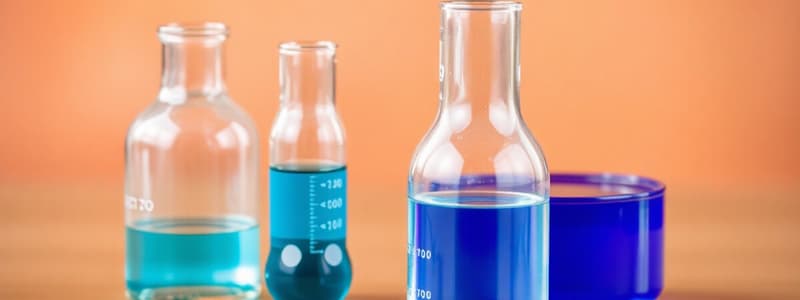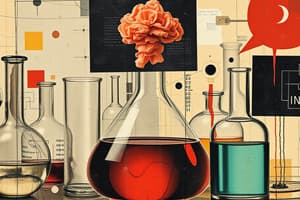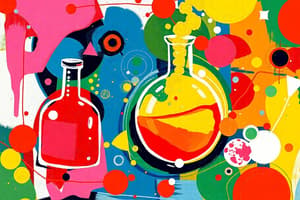Podcast
Questions and Answers
What does chemistry primarily deal with?
What does chemistry primarily deal with?
- The identification and properties of substances (correct)
- The study of energy sources only
- The analysis of astronomical phenomena
- The exploration of biological organisms
Which of the following best defines matter?
Which of the following best defines matter?
- A concept related to chemical reactions
- A substance that only produces energy
- A condition that defines the state of electrons
- A physical substance with mass and occupies space (correct)
What determines the state of matter?
What determines the state of matter?
- The amount of energy available
- The volume of the substance
- The molecular structure (correct)
- The temperature alone
Which term describes power derived from chemical or physical resources?
Which term describes power derived from chemical or physical resources?
How does chemistry contribute to forming new substances?
How does chemistry contribute to forming new substances?
Which of the following is an example of a homogenous mixture?
Which of the following is an example of a homogenous mixture?
What distinguishes compounds from mixtures?
What distinguishes compounds from mixtures?
Which kind of change describes a process where the original substance changes into a new substance?
Which kind of change describes a process where the original substance changes into a new substance?
Which process is described as the separation of metals from compounds involving melting?
Which process is described as the separation of metals from compounds involving melting?
Which option is an example of a colloid?
Which option is an example of a colloid?
What fundamental aspect characterizes all chemical reactions?
What fundamental aspect characterizes all chemical reactions?
Who proposed the idea of spontaneous generation?
Who proposed the idea of spontaneous generation?
What is the primary purpose of food preservation techniques?
What is the primary purpose of food preservation techniques?
What is the boiling point of a substance?
What is the boiling point of a substance?
Which of the following correctly describes ductility?
Which of the following correctly describes ductility?
What does the term solubility refer to?
What does the term solubility refer to?
What defines a pure substance?
What defines a pure substance?
Which chemical property describes the ability to burn?
Which chemical property describes the ability to burn?
What effect does a reaction with acids typically have on materials?
What effect does a reaction with acids typically have on materials?
What does conductivity indicate about a substance?
What does conductivity indicate about a substance?
Which state represents a substance that exists as a gas?
Which state represents a substance that exists as a gas?
What did John Dalton propose about atoms?
What did John Dalton propose about atoms?
Which model of the atom proposed that electrons exist in specific orbits around the nucleus?
Which model of the atom proposed that electrons exist in specific orbits around the nucleus?
What experimental observation led Rutherford to conclude that atoms have a dense nucleus?
What experimental observation led Rutherford to conclude that atoms have a dense nucleus?
Which of the following best describes the Raisin Bun Model proposed by J.J. Thompson?
Which of the following best describes the Raisin Bun Model proposed by J.J. Thompson?
In the Quantum Mechanical Model, how are the positions of electrons described?
In the Quantum Mechanical Model, how are the positions of electrons described?
What fundamental assumption is made in Dalton's atomic theory?
What fundamental assumption is made in Dalton's atomic theory?
What phenomenon did Bohr use to support his model of the atom?
What phenomenon did Bohr use to support his model of the atom?
What characteristic did Ernest Rutherford assign to the nucleus of an atom?
What characteristic did Ernest Rutherford assign to the nucleus of an atom?
Flashcards
Chemistry
Chemistry
The branch of science that studies matter, its properties, and interactions.
Matter
Matter
Physical substance that has mass and occupies space.
Energy
Energy
Power derived from chemical or physical resources.
State
State
Signup and view all the flashcards
Properties
Properties
Signup and view all the flashcards
Boiling Point
Boiling Point
Signup and view all the flashcards
Freezing Point
Freezing Point
Signup and view all the flashcards
Malleability
Malleability
Signup and view all the flashcards
Ductility
Ductility
Signup and view all the flashcards
State of Matter
State of Matter
Signup and view all the flashcards
Conductivity
Conductivity
Signup and view all the flashcards
Solubility
Solubility
Signup and view all the flashcards
Pure Substances
Pure Substances
Signup and view all the flashcards
Compounds
Compounds
Signup and view all the flashcards
Mixtures
Mixtures
Signup and view all the flashcards
Homogeneous Mixture
Homogeneous Mixture
Signup and view all the flashcards
Heterogeneous Mixture
Heterogeneous Mixture
Signup and view all the flashcards
Suspension
Suspension
Signup and view all the flashcards
Colloid
Colloid
Signup and view all the flashcards
Chemical Reactions
Chemical Reactions
Signup and view all the flashcards
Spontaneous Generation
Spontaneous Generation
Signup and view all the flashcards
Pneuma
Pneuma
Signup and view all the flashcards
Anima
Anima
Signup and view all the flashcards
Billiard Ball Model
Billiard Ball Model
Signup and view all the flashcards
Raisin Bun Model
Raisin Bun Model
Signup and view all the flashcards
Planetary Model
Planetary Model
Signup and view all the flashcards
Gold Foil Experiment
Gold Foil Experiment
Signup and view all the flashcards
Bohr Model
Bohr Model
Signup and view all the flashcards
Quantum Mechanical Model
Quantum Mechanical Model
Signup and view all the flashcards
Study Notes
Unit A: Chemistry
- Chemistry is the branch of science that identifies substances, investigates their properties and how they interact, combine and change, and uses these processes to create new substances.
Terms You Should Know
- Matter: Has mass and occupies space.
- Energy: Derived from chemical or physical resources.
- State: A physical condition determined by molecular structure.
Physical Properties of Matter
- Boiling/Condensation Point: The temperature at which a substance boils or condenses.
- Freezing/Melting Point: The temperature at which a substance freezes or melts.
- Malleability: The ability to be beaten or rolled into sheets.
- Ductility: The ability to be stretched without breaking.
- State: Existence as solid, liquid, or gas.
- Crystal Formation: Crystalline appearance.
- Magnetism: Magnetic attraction between objects.
- Conductivity: Ability to conduct heat or electricity.
- Solubility: Ability to dissolve.
- Color: The color of the material.
States of Matter
- Solid: Molecules held in a fixed pattern.
- Liquid: Molecules close together, free to move.
- Gas: Molecules widely separated.
Chemical Properties of Matter
- Ability to Burn: Combustion (flame, heat, light).
- Flash Point: Temperature needed to ignite a substance.
- Behaviour in Air: Tendency to degrade, react, or tarnish.
- Reaction with Water: Tendency to corrode or dissolve.
- Reaction with Acids: Corrosion, sometimes bubble formation.
- Reaction with Heat: Tendency to melt or decompose.
- Reaction to Red/Blue Litmus: Red (acid), blue (basic), no colour change (neutral).
Properties & Classification of Matter
- Matter: Pure substances (elements and compounds) or mixtures (solutions, mechanical mixtures, suspensions, colloids).
Breaking it Down: Pure Substances
- Pure Substances: Contain only one type of particle, cannot be broken down into another substance by physical means.
- Elements: Made up of one type of atom (gold, oxygen, diamond, etc).
- Compounds: Made up of more elements that are chemically combined in specific ratios (water, salt, crystals).
Breaking it Down: Mixtures
- Mixtures: Contain two or more pure substances.
- Homogenous: Appears to be made of one substance and looks the same throughout (sugar & water mixed).
- Heterogenous: Separate components are visible.
- Suspension: Mixture in which particles are dispersed throughout a fluid (sand & water).
- Colloid: Particles suspended, cannot be filtered apart easily (gelatin, milk).
Matter Changes
- Chemical Changes: A chemical reaction forms new products that have different properties than the original substances, is irreversible. (combustion, rotting, rusting, digestion).
- Physical Changes: The substance changes form but the chemical identity stays the same. Physical changes are often reversible (melting, shredding, boiling, chopping).
Identifying Chemical Reactions
- All chemical reactions are characterized by the formation of a new substance with new physical and/or chemical properties, and by the release or absorption of energy.
Ancient Chemistry
- Metallurgy: The science of producing and using metals.
- Annealing: Heating copper to make it stronger and less brittle.
- Smelting: Separating metals from compounds by melting them.
Food Chemistry
- The development of food preservation techniques was necessary for human survival and has been known for thousands of years. These techniques include cooking, freezing, drying, salting, smoking, spicing, fermenting.
Atomic Theory
-
Our understanding of atomic structure has changed over time.
-
Models of the atom are revised or new models emerge to incorporate new experimental evidence
Idea 1: Spontaneous Generation
- The idea that living things can be generated from non-living matter.
Idea 2: The Billiard Ball Model
- Dalton believed that matter is made up of indivisible atoms. Atoms of the same element are identical. Atoms combine in fixed ratios to form compounds.
Idea 3: The Raisin Bun Model
- Thomson proposed that atoms contain both positive and negative charges. Small negative charges are embedded in a positive particle.
Idea 4: The Planetary Model
- Rutherford suggested that the atom has a small, dense, positively charged nucleus (center). Negative electrons orbit the nucleus like planets around the sun.
Idea 5: The Bohr Model
- Bohr proposed that electrons orbit the nucleus in specific energy levels.
Idea 6: The Quantum Mechanical Model
- The modern model describes the electron's position in terms of probabilities. Electrons exist in certain regions around the nucleus.
Studying That Suits You
Use AI to generate personalized quizzes and flashcards to suit your learning preferences.




